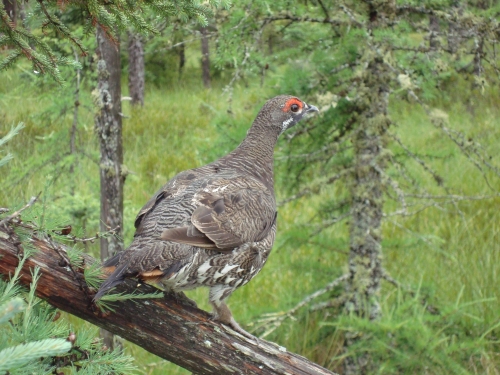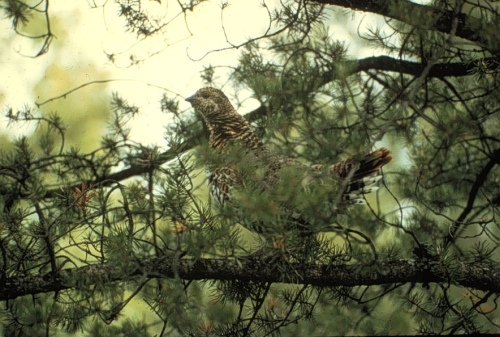Plants and Animals
Canachites canadensis Spruce grouse
Key Characteristics
The Spruce grouse is a chicken-like bird with a length of 16 inches (41 cm) and a wingspan of 22 inches (56 cm). It has a stocky shape with a short neck and a tail. Females may be grayish or reddish but both color phases have strongly barred breast feathers. Males have a distinctive pattern of white spots on a darker background below, white tips on their uppertail coverts and a red comb over the eye. They have black necks and a dark back and wings.
Status and Rank
US Status: No Status/Not Listed
State Status: T - Threatened (legally protected)
Global Rank: G5 - Secure
State Rank: S2 - Imperiled
Occurrences
| County | Number of Occurrences | Year Last Observed |
|---|---|---|
| Baraga | 3 | 2003 |
| Chippewa | 3 | 2023 |
| Crawford | 1 | 2010 |
| Delta | 1 | 2009 |
| Dickinson | 1 | 2013 |
| Luce | 3 | 2008 |
| Mackinac | 1 | 2007 |
| Marquette | 1 | 2004 |
| Ogemaw | 1 | 2016 |
| Oscoda | 3 | 2007 |
| Schoolcraft | 1 | 2014 |
Information is summarized from MNFI's database of rare species and community occurrences. Data may not reflect true distribution since much of the state has not been thoroughly surveyed.
Habitat
Spruce Grouse occur throughout the Upper Peninsula and parts of the Northern Lower Peninsula in areas dominated by coniferous forests such as jack pine, black and white spruce, and tamaracks. Ideal habitat in Michigan occurs where black spruce and jack pine mix with scattered small openings with scattered decaying logs and stumps.
Natural Community Types
For each species, lists of natural communities were derived from review of the nearly 6,500 element occurrences in the MNFI database, in addition to herbarium label data for some taxa. In most cases, at least one specimen record exists for each listed natural community. For certain taxa, especially poorly collected or extirpated species of prairie and savanna habitats, natural community lists were derived from inferences from collection sites and habitat preferences in immediately adjacent states (particularly Indiana and Illinois). Natural communities are not listed for those species documented only from altered or ruderal habitats in Michigan, especially for taxa that occur in a variety of habitats outside of the state.
Natural communities are not listed in order of frequency of occurrence, but are rather derived from the full set of natural communities, organized by Ecological Group. In many cases, the general habitat descriptions should provide greater clarity and direction to the surveyor. In future versions of the Rare Species Explorer, we hope to incorporate natural community fidelity ranks for each taxon.
Management Recommendations
Avoid mowing, brush cutting/removal, or herbicide application during the nesting season from mid-April through July. Insecticide applications may also reduce the prey items available to adults and chicks.
Active Period
Brood Rearing from fourth week of May to third week of July
Nesting from fourth week of April to fourth week of May
Survey Methods
Although they may seem quite tame, Spruce grouse can be very secretive and relatively quiet. Playing recorded calls of females in spring can be useful in eliciting vocalizations by males.
Play conspecific call
Survey Period: From first week of April to fourth week of May
Time of Day: Daytime
References
Survey References
- Bibby, C.J., N.D. Burgess, and D.A. Hill. 1992. Bird Census Techniques. Academic Press, New York.
Technical References
- Brewer, R., G. A. McPeek, and R. J. Adams Jr., eds. 1991. The Atlas of Breeding Birds of Michigan. Michigan State University Press, East Lansing. 650pp.
- Sibley, D.A. 2000. The Sibley Guide to Birds. Knopf, Toronto. 544pp.



